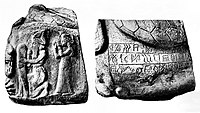Puzur-Inshushinak
King of Elam From Wikipedia, the free encyclopedia
Puzur-Inshushinak (Linear Elamite: ![]() Puzur Sušinak; Akkadian: 𒌋𒌋𒀭𒈹𒂞, puzur3-dinšušinak, also 𒅤𒊭𒀭𒈹𒂞, puzur4-dinšušinak "Calling Inshushinak"; fl. c. 2100 BC[3]), also sometimes thought to read Kutik-Inshushinak in Elamite,[4] was a king of Elam, and the last from the Awan dynasty according to the Susa kinglist.[5] He mentions his father's name as Šimpi-išhuk, which, being an Elamite name, suggests that Puzur-Inshuhinak himself was Elamite.[6]
Puzur Sušinak; Akkadian: 𒌋𒌋𒀭𒈹𒂞, puzur3-dinšušinak, also 𒅤𒊭𒀭𒈹𒂞, puzur4-dinšušinak "Calling Inshushinak"; fl. c. 2100 BC[3]), also sometimes thought to read Kutik-Inshushinak in Elamite,[4] was a king of Elam, and the last from the Awan dynasty according to the Susa kinglist.[5] He mentions his father's name as Šimpi-išhuk, which, being an Elamite name, suggests that Puzur-Inshuhinak himself was Elamite.[6]
| Puzur-Inshushinak 𒅤𒊭𒀭𒈹𒂞 | |
|---|---|
 | |
| King of Elam | |
| Reign | c. 2100 BC |
| Predecessor | Possibly Hita'a |
| Successor | Position abolished |
| Father | Shinpi-khish-khuk |

𒅤𒊭𒀭𒈹𒂞 𒑐𒋼𒋛 𒈹𒂞𒆠 𒄊𒀴 𒈣𒋾 𒉏𒆠
puzur-inshushinak ensi shushiki skakkanakku mati NIMki
"Puzur-Inshushinak, Ensi of Susa and Shakkanakku of Elam"
"Table au Lion", Louvre Museum[2]
puzur-inshushinak ensi shushiki skakkanakku mati NIMki
"Puzur-Inshushinak, Ensi of Susa and Shakkanakku of Elam"
"Table au Lion", Louvre Museum[2]
In the inscription of the "Table au Lion", he appears as "Puzur-Inshushin(ak) Ensi (Governor) of Susa, Shakkanakku (Military Governor) of the country of Elam" (𒅤𒊭𒀭𒈹𒂞 𒑐𒋼𒋛 𒈹𒂞𒆠 𒄊𒀴 𒈣𒋾 𒉏𒆠 puzur-inshushinak ensi shushiki skakkanakku mati NIMki), a title used by his predecessors Eshpum, Epirmupi and Ili-ishmani as governors of the Akkadian Empire for the territory of Elam.[2][7] In another inscription, he calls himself the "Mighty King of Elam", suggesting an accession to independence from the weakening Akkadian Empire.[8]
Rule
Summarize
Perspective
His father was Shinpi-khish-khuk, the crown prince, and most likely a brother of Khita. Kutik-Inshushinak's first position was as governor of Susa, which he may have held from a young age. Around 2110 BC his father died, and he became crown prince in his stead.
Elam had been under the domination of Akkad since the time of Sargon, and Kutik-Inshushinak accordingly campaigned in the Zagros mountains on their behalf. He was greatly successful as his conquests seem to have gone beyond the initial mission. Early on his inscriptions were in Akkadian but over time they came to be also in Linear Elamite.[9]
Around 2090 BC, he asserted his independence from king Shar-Kali-Sharri the Akkad, which had been weakening ever since the death of Naram-Sin, thus making himself king of Elam.[10] He conquered Anshan and managed to unite most of Elam into one kingdom.[10]
According to the inscriptions of Ur-Nammu, Puzur-Inshushinak conquered numerous cities in central Mesopotamia, including Eshnunna and Akkad, and probably Akshak.[11] His conquests probably encroached considerably on Gutian territory, gravely weakening them, and making them unable to withstand the Neo-Sumerian revolt of Utu-hengal.[12]

The Elamite name of Puzur-Inshushinak:

Pu-zu-r Šu-ši-na-k
in the Linear Elamite script (right to left).[13]

Pu-zu-r Šu-ši-na-k
in the Linear Elamite script (right to left).[13]
He built extensively on the citadel at Susa, and encouraged the use of the Linear Elamite script to write the Elamite language. This may be seen as a reaction against Sargon's attempt to force the use of Akkadian. Most inscriptions in Linear Elamite date from the reign of Kutik-Inshushinak.
His achievements were not long-lasting, for after his death the linear script fell into disuse, and Susa was overrun by the Third dynasty of Ur under Ur-Nammu and his son Shulgi.[10] Ur had held control over Susa after the demise of Puzur-Inshushinak, and they built numerous buildings and temples there. This control was continued by Shulgi as shown by his numerous dedications in the city-state.[14] He also engaged in marital alliances, by marrying his daughters to rulers of eastern territories, such as Anshan, Marhashi and Bashime.[14] Concomitantly, Elam fell under control of the Shimashki dynasty (also Elamite of origin).[15]
It is now known that his reign in Elam overlapped with that of Ur-Nammu of Ur-III,[16] although the previous lengthy estimates of the duration of the intervening Gutian dynasty and rule of Utu-hengal of Uruk had not allowed for that synchronism. Ur-Nammu, who styled himself "King of Sumer and Akkad" is probably the one who, early in his reign, reconquered the northern territories that had been occupied by Puzur-Inshushinak, before going on to conquer Susa.[17]
Statue of Puzur-Inshushinak
The bottom part of a statue, probably representing Puzur-Inshushinak himself, is visible in the Louvre Museum, Sb 55.[18][19] The statue lists the numerous victories of Puzur-Inshushinak over neighbouring territories, and particularly mentions the submission of the king of Shimashki who "kissed his feet".[20]
- Right side
- Feet with sandals
- Inscriptions of the statue of Puzur-Inshushinak (left side)
Inscriptions
Summarize
Perspective
A possible mention of Puzur-Inshushinak appears in one of Puzer-Mama's inscriptions,[21][22] but this is considered doubtful by Walter Sommerfeld and Piotr Steinkeller.[23]
- Dedication by Puzu-Inshunishak in the Akkadian language. Louvre Museum, reference Sb 160.[24]
- Bilingual Linear Elamite-Akkadian inscription of king Puzur-Inshushinak "Ensi of Susa". Table of the Lion, Louvre Museum Sb 17.[25]
- Linear Elamite inscription of king Kutik-Inshushinak, "Table du Lion", Louvre Museum Sb 17.
- Door socket with inscription "Puzur-Inshushinak Ensi of Susa" (𒅤𒊭𒀭𒈹𒂞 𒑐𒋼𒋛 𒈹𒂞𒆠)
- Statue of goddess Narundi dedicated by Puzur-Inshushinak, with inscriptions in Linear Elamite and in Akkadian, Louvre Museum
- "Puzur-Inshushinak, Governor of Susa", on the statue of the Goddess Narundi
- Perforated stone, with Linear Elamite text. Louvre Museum Sb6 Sb177
- Puzur-Inshushinak on the Awan Kings List.[26]
- A God putting a foundation nail in the ground, protected by a Lama goddess, in front of a roaring lion. Coiled snake on top. Inscriptions in Linear Elamite and Akkadian. Time of Puzur-Inshushinak, circa 2100 BC, Louvre Museum.[27]
- Clay cone with Linear Elamite text. Louvre Museum Sb 17830. Reign of Puzur-Inshushinak.[28]
References
Wikiwand - on
Seamless Wikipedia browsing. On steroids.














